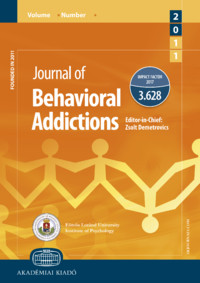Problematic social media use is associated with the evaluation of both risk and ambiguity during decision making
Problematic social media use is associated with the evaluation of both risk and ambiguity during decision making
Author(s): Dar Meshi, David Freestone, Ceylan Özdem-MertensSubject(s): Behaviorism
Published by: Akadémiai Kiadó
Keywords: social media addiction; social networking addiction; decision making; risk; ambiguity; wheel of fortune task
Summary/Abstract: Background and aims: People can engage in excessive, maladaptive use of social media platforms. This problematic social media use mirrors substance use disorders with regard to symptoms and certain behavioral situations. For example, individuals with substance use disorders demonstrate aberrations in risk evaluations during decision making, and initial research on problematic social media use has revealed similar findings. However, these results concerning problematic social media use have been clouded by tasks that involve learning and that lack a clear demarcation between risky and ambiguous decision making. Therefore, we set out to specifically determine the relationship between problematic social media use and decision making under both risk and ambiguity, in the absence of learning. Methods: We assessed each participant’s (N 5 90) self-reported level of problematic social media use. We then had them perform the wheel of fortune task, which has participants make choices between a sure option or either a risky or ambiguous gamble. In this way, the task isolates decisions made under risk and ambiguity, and avoids trial-to-trial learning. Results: We found that the greater an individual’s problematic social media use, the more often that individual choses high-risk gambles or ambiguous gambles, regardless of the degree of ambiguity. Discussion and conclusions: Our findings indicate that greater problematic social media use is related to a greater affinity for high-risk situations and overall ambiguity. These findings have implications for the field, specifically clarifying and extending the extant literature, as well as providing future avenues for research.
Journal: Journal of Behavioral Addictions
- Issue Year: 10/2021
- Issue No: 3
- Page Range: 779-787
- Page Count: 9
- Language: English

